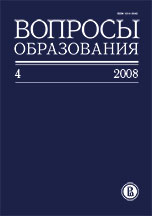Most read articles by the same author(s)
- Mark Agranovich, Возможности анализа образовательных систем на основе результатов ЕГЭ , Voprosy obrazovaniya / Educational Studies Moscow: No 2 (2004)
- Mark Agranovich, Passing the Funding of Professional Training to the Regional Level. An Attempt to Evaluate the Consequences on the Example of Primary Professional Education , Voprosy obrazovaniya / Educational Studies Moscow: No 2 (2005)
- Mark Agranovich, Indicators in Education Management: What do they Indicate and Where do they Lead? , Voprosy obrazovaniya / Educational Studies Moscow: No 1 (2008)









